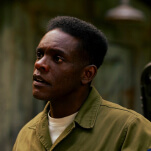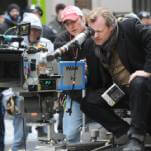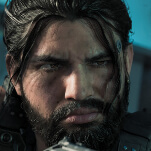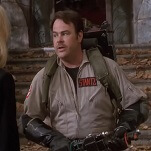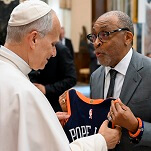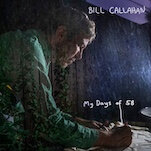Generation Kill: "Get Some"

(Note: I’ll be covering this series for its full seven-week run. Each recap will include spoilers for scenes that happen throughout the hour, and is therefore intended for those who have seen the episode first.)
“The Marine Corps is like America’s little pit bull. They beat us, mistreat us, and every once in a while, they let us out to attack somebody.” —Cpl. Ray Person
Whenever you achieve something as a group in grades K-12, you get a pizza party. It’s your greasy, cheesy reward for a job well done, and it tastes especially good at school, far more delicious than it does at home. (Ditto television. Kids who watch television night and day in their living rooms are absolutely mesmerized when the TV cart gets wheeled into the classroom.) The commonplace suddenly becomes a special treat, and it’s safe to say that kids are willing to sacrifice an excessive amount of time and energy just to have that pizza at the end of the line.
That same bizarre psychological phenomenon comes into play during “Get Some,” the first episode of Generation Kill, the riveting new miniseries from David Simon and Ed Burns, creators of The Wire. When a convoy of delivery cars from a Pizza Hut in Kuwait City arrives to serve the Marines of the First Recon unit, there’s a lot of excitement among the grunts, who are happy to devour something as familiar and all-American as pizza after choking down those MREs (Meals Ready to Eat). A few are more skeptical, as they should be. After all, they’re being bought off cheap: In exchange for a few slices, they’ll be among the first American soldiers to invade Iraq.
Oh, and there’s not enough pizza to go around. Which pretty much says all that needs to be said about this series.
Welcome to The Wire, Middle East division. The Game has changed, but the rules are more or less the same, and it’s always the little guy, trying to do his best under impossible circumstances, who comes out on the bottom. Based on the book by Rolling Stone reporter Evan Wright—a piece of war reporting Simon compared to Michael Herr’s Dispatches and Michael Kelly’s Martyrs’ War—Generation Kill has to be the most realistic depiction of war that I’ve ever come across. Not necessarily the best, mind, but the most scrupulous in terms of detailing exactly how soldiers talk (officially and casually), what their needs and conditions are like, and how war is waged on contemporary battlegrounds. And really, I’d expect nothing less from Simon and Burns, who hold journalistic verisimilitude above all other aesthetic values. This makes their work difficult to access at times and even a little artless, since they really have no use for impressionistic flourishes. This miniseries is like the anti-Apocalypse Now.
As with The Wire, Simon and Burns lead the viewer through the action with a bare minimum of hand-holding. That has led some critics to complain on a couple of fronts: One, that the military jargon is so thick that it’s hard to know what is going on. Two, that there are so many characters introduced that it’s hard to tell which is which. Time really solves both problems: If you need to know what all the terms and nicknames mean, you can download this helpful glossary, but I think if you pay close enough attention, the language starts to make sense in much the way it does in A Clockwork Orange. (The oft-used “Oscar Mike” means “on the move.”) And goodness knows, The Wire offered up dozens of characters over five seasons, and it took some time to get a sense of them, too.
Helpfully, the head honcho of operations here is nicknamed The Godfather (Chance Kelly), because he speaks in a Marlon Brando voice. He also refers to himself in the third person, which amplifies his noxious personality. (Wire fans will recognize him as a leader in the Rawls/Burrell mode.) But Generation Kill mainly concerns itself with the grunts’ point of view, and there are admittedly quite a few to sort out. For now, I’ll just introduce the four who occupy the journalist’s Humvee: Sgt. Brad Colbert (Alexander Skarsgard), a solid and intelligent leader who keeps his unstable car-mates together while eyeing the bigger picture; Cpl. Ray Person (James Ransone, known for playing Ziggy on The Wire), who drives the Humvee and tends to run off at the mouth; Lance Cpl. Trombley, a disturbed gunner who’s a little too anxious to see some action; and Evan Wright (Lee Turgeson), a Rolling Stone writer who has to shake off suspicion that he’s a liberal peacenik there to tar them all as rapists and baby killers.
From the beginning, the Marines are working in an impossible gray area: They’re told not to kill Iraqi civilians while still staying aggressive, which calls for the sort of nuance that wartime conditions don’t always allow them to apply. Plus, as we’ll see throughout the series, the Rules Of Engagement can change at any time: At one moment, they can be told not to shoot anyone unless fired upon—a scary proposition when two trucks full of potentially armed men pull up in front of them—and the next, they’re supposed to fire on anything that moves. These are men who are used to taking orders, but when those orders are both inconsistent and difficult to follow, mistakes are unavoidable.




